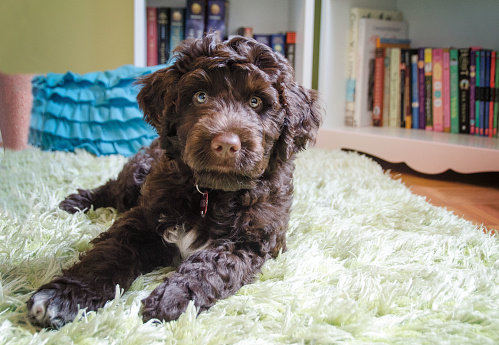Table of Contents
Key Takeaways
- Every type of dog sheds at least a little bit.
- However, some dogs only shed a small amount and are better for people with allergies.
- Dogs with shorter hair tend to shed less.
- Excessive hair loss could indicate a health problem in your dog.
Whether you have allergies or you simply like to keep a tidy home, you may be interested in adopting a dog that doesn’t shed. The not-so-good news is that almost every dog has a tiny bit of shedding. The good news is that there are many dog breeds who shed only a minute amount. Even the hairless Chinese Crested will have a little bit of shedding throughout its lifetime, but you most likely won’t even notice it.
Maintenance and grooming
Though your vacuum may get a break, welcoming home a low-shedding dog doesn’t get you off the hook for grooming altogether. All dogs need occasional bathing (some more than others) and many low-shedding breeds have hair that continues to grow which means they need regular brushing and haircuts as well.
Pet hair and allergies
The pet hair itself is not actually what causes allergies. People with dog allergies are reacting to a harmless protein in the dog’s dander (dead skin cells), saliva, or urine. It’s important to note that even if they don’t shed much, dog breeds that drool would likely not be a good choice for those with allergies.
The reason allergies may be more pronounced with shedding dogs is because shed dog hair can carry dander and/or traces of dog saliva as well as other allergens like pollen. No dog is 100% hypoallergenic because all dogs produce some level of dander, but low-shedding dogs can make a difference for allergy sufferers.
Short fur means less shedding
The most indicative characteristic of a shed-free canine is the length of its fur. You can tell that a dog with short fur will most likely not have a shedding problem: The Shar Pei, Rhodesian Ridgeback, Vizsla, and Chihuahua shed such a small amount because their fur is very short; this also applies to Mastiffs, Pit Bulls, Doberman Pinschers, Boxers, Greyhounds, and more.
1. Shar-Pei
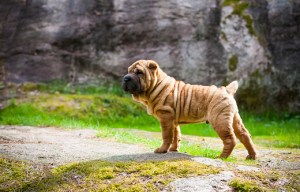
This wrinkly pup is described as “fascinating but challenging.” A tried and true loyal dog that expresses aloofness to fear around strangers and other dogs. The American Kennel Club says, “Shar-Pei are serene dogs, but they will meet a perceived threat with tenacity and vigor. Early training and socialization are essential—a dominant adult Shar-Pei without them is a serious problem waiting to happen.” Great guard dogs.
2. Rhodesian Ridgeback
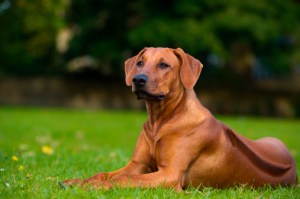
Did you know the Rhodesian Ridgeback is well-known for their skill at tracking (“but never, ever killing”) lions? These independent, willful dogs have strong personalities, are faithful family pets, but can be overwhelming for many inexperienced pet parents. They’re known to be active and spirited.
3. Vizsla
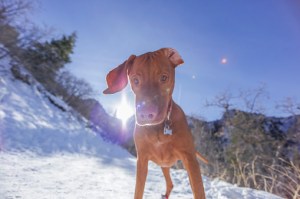
The Vizsla is a Hungarian dog, usually recognized by its red coat. They’re lean athletes who are great at home and hard workers when given the opportunity. They’ve been bred to have a very tight bond with their pet parents and family, and because of this may hate to be left alone (watch out for separation anxiety). They’re also incredibly intelligent, so get ready for a pup who needs a job – and not an easy one.
4. Chihuahua

Small but mighty! The Chihuahua is well-known for being feisty, funny, and fully alert. They’re one of the oldest breeds in both North and South America, and rarely top out over 6lbs (unless mixed with other breeds, of course!). They hate the cold, however, so prepare to invest in sweaters in colder climates.
5. Mastiffs
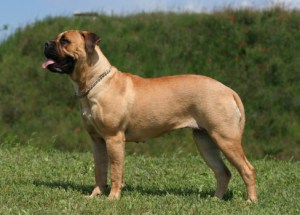
Mastiffs, like the Bull Mastiff above, are massive, heavy-boned, and strong. They’re also sweet and docile to their “pack,” meaning their family, and are patient and loving. While many can outweigh a full-grown adult human, breeders recommend committing to a powerhouse of a dog only if you’re ready to train, train, train.
6.Pit bulls
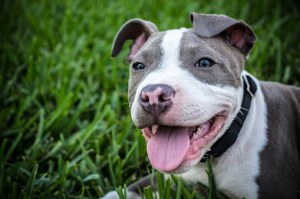
“Pit bull” is the common name for the purebreds American Pit Bull Terrier, American Staffordshire Terrier, American Bully, and Staffordshire Bull Terrier, as well as mixes of these breeds. Their size can range from medium to large (30lbs to 80lbs+). They’re smart, athletic dogs who are very loyal to their humans, but can have a high prey drive.
7. Doberman Pinschers
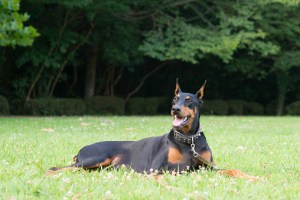
Known as guard dogs in film, these powerful, loyal dogs are athletic, sleek, and strong. Described as “incomparably fearless and vigilant,” the Doberman is also quick on its feet and one heck of a guard dog. In a family, they’re smart, lovable, and will go the distance to protect their pack.
8. Boxers
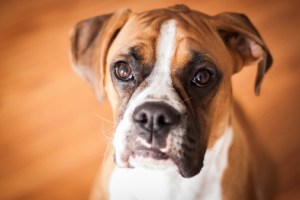
Just read this ‘review’ from the AKC: “Loyalty, affection, intelligence, work ethic, and good looks: Boxers are the whole doggy package. Bright and alert, sometimes silly, but always courageous, the Boxer has been among America’s most popular dog breeds for a very long time.” Boxers are fun, funny, and a great pet.
9. Greyhounds
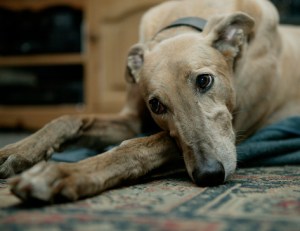
The speediest of the speedy, Greyhounds are not only built for racing, they’re also sweet, gentle, and beautiful. They’ve been bred to be highly aerodynamic, however, nowadays plenty of rescues rehome retired Greyhounds to loving families where they can kick back and relax. For a much smaller version, don’t forget the Italian Greyhound.
10. Bulldogs (American, English, and French)
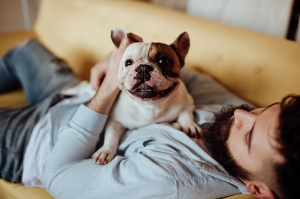
Bulldogs of all kinds have short, unsheddable coats. Check out the American bulldog for a longer-legged (and longer snouted) version, while the English is the traditional bulldog’s bulldog, and the Frenchie is that adorable, good-natured little pup you see almost everywhere. Bulldogs are known for their friendly attitudes, although be careful of overheating and over-exercising: smoosh faces can run into breathing trouble.
Curly-Haired Breeds Shed Less
The Portuguese Water Dog (now famous because President Obama has a pair) is touted as being both hypoallergenic and sheds very little, as does the poodle. (If it’s a hypoallergenic dog you’re after, the American Kennel Club has a great guide). It’s reported that silky, long-haired dogs do not shed as much either, possibly due to the fact that their “fur” is more human-like and doesn’t become airborne (see the Lhasa Apso and Yorkshire Terrier).
11. Portuguese Water Dog
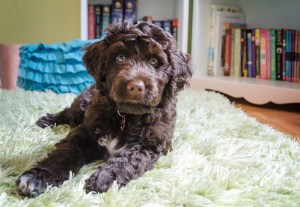
President Obama popularized the PWD (yep, that’s a verified acronym for the pooch), bringing this happy, friendly breed into the spotlight. PWDs are easy to train and very smart, and have a history of being a fisherman’s BFF. These medium-sized dogs rarely hit over 60 lbs.
12. Poodle

The ever-popular poodle is a great non-shedding choice for families: they come in various sizes (Standard, Miniature, or Toy), and they’re very smart. Their curly coat is hypoallergenic, but the real appeal comes with what the AKC says about them: “Poodles are eager, athletic, and wickedly smart ‘real dogs’ of remarkable versatility.”
13. Lhasa Apso
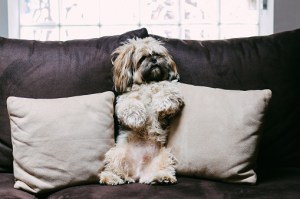
Who knew? Lhasa apsos are the comedians of the group! Known for their “merry” soul, the Lhasa apso is also smart and confident but can be aloof around strangers. Another fun fact: this pup originated in Tibet.They were bred as small but elegant guard dog at Buddhist monasteries, alerting the monks to any intruders who might enter.
14. Yorkshire Terrier
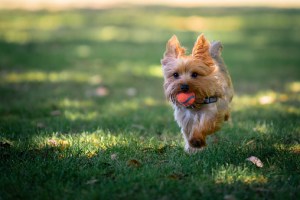
They may look darling, but Yorkshire Terriers are still terriers! They can be feisty, and were known ratters during Victorian times. They can even be bossy. The AKC says, “Yorkies are long-lived and hypoallergenic (the coat is more like human hair than animal fur), and they make fine little watchdogs. This is a true “personality breed,” providing years of laughs, love, and close companionship.”
Hairless Breeds = Almost No Shedding
The crème de la crème of shed-free dogs are the hairless breeds: The Chinese Crested, Mexican Hairless (Xoloitzcuintli), Peruvian Hairless, Ecuadorian Hairless, and American Hairless Terrier all will shed next to nothing, and (bonus) they require a really cute wardrobe for the winter.
15. Chinese Crested
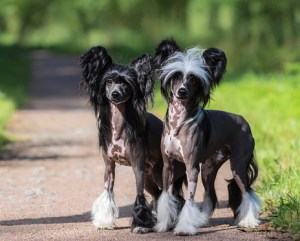
Definitely the coolest looking breed on the block, the Chinese Crested is affectionate, sweet, and a wonderful companion. The breed can be hairless with tufts of hair on the head, tail, and ankles, and there is a coated Chinese Crested too, called the “powderpuff.”
16. Mexican Hairless (Xoloitzcuintli), Peruvian Hairless, Ecuadorian Hairless, and American Hairless Terrier

The Xoloitzcuintli (pronounced “show-low-eats-QUEENT-lee”) is actually an ancient Aztec breed, but today is a loving, loyal family member (and vigilant watchdog) that comes in Standard, Mini, and Toy. The Peruvian Hairless is also known as the Peruvian Inca Orchid, a sighthound found in – you guessed it – Peru. They also are in small, medium, and large sizes, just like the Ecadorian Hairless Dog (native to Ecuador). Finally, the American Hairless Terrier is from Louisiana with a true terrier personality. All are smart, alert, and make for good hunters, so their prey drive might be high.
Coping with a Shedding Dog
So what do you do if you’ve already got a dog and he or she sheds? If you’re at your wit’s end, there are a couple tricks that can help!
- Make sure your dog’s breed is known for shedding a lot to rule out the possibility of a health problem that’s causing excessive hair loss; sometimes it’s worth a trip to the vet to see if something is up. Just like humans, shedding may be a sign of a vitamin deficiency and it could be something as simple as nutrition—lots of pet owners notice a decrease in shedding after they’ve changed their pet’s diet.
- If your dog was meant to shed (looking at you, adorable American Eskimo), you have to be rigorous with a grooming routine: brush and bathe regularly at home and visit the groomer for major maintenance.
- Other fur upkeep adheres to common housekeeping rules: keep your vacuum running smoothly with clean filters and empty compartments, and this also applies to your air conditioning vents—sometimes overlooked when you’re drowning in fur. Some owners swear by running a dryer sheet over their pet (try natural dryer sheets if you’re concerned about the chemicals), others use Velcro, tape, and lint rollers faithfully before resorting to heavy-duty made-for-fur brooms and vacuums.
Got a pup with lots of love but not a lot of fur? We’d love for you to share a picture of your adorable doggo with us on Instagram by tagging #gohealthypaws.
